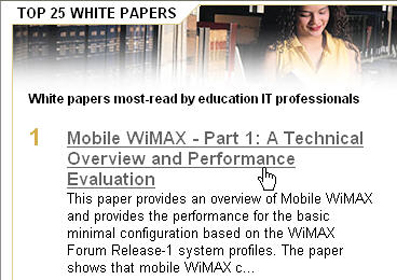Education IT: "bring on Mobile WiMAX;" Profs: "not in my classroom you don't"


On our ZDNet Education IT main page (we call them "front doors" here in our shop), you can see a list of the top 25 most-read white papers by IT professionals in the education sector.
Right there at #1 is Mobile WiMAX - Part 1: A Technical Overview and Performance Evaluation.
Click thru on that link and you will read the paper's premise:
This paper provides an overview of Mobile WiMAX and provides the performance for the basic minimal configuration based on the WiMAX Forum Release-1 system profiles. The paper shows that mobile WiMAX can provide tens of megabits per second of capacity per channel from each base station with a baseline configuration. Some of the advanced features such as Adaptive Antenna Systems (AAS) which can significantly improve the performance are discussed but not included in the performance analysis.
Now, wouldn't a reasonable person be able to put 2+2 2-gether and assume that this 53-page study's top rank among education IT's is because they are interested in implementation and management best practices for Mobile WiMAX on college campuses?
I ask you, how does that square away with the news today that some clueless Luddite professors are banning broadband wireless-enabled laptops in their classrooms?
This is the same mentality that insisted on slide rules long after slide rules were long gone from the real world. (And like Sam Cooke sang in "Wonderful World," I don't know what a slide rule is for).
An as to the argument that students with Wi-Fi or WiMAX-enabled notebooks won't pay attention, I say this.
I am a technologist but I've also taught in college where I dealt with lots of rock and roll slackers. Yes, I know that back-of-classroom daydreaming and note-passing back in 1986 is kind of like MySpace in 2006. But even back then I learned that if you make it interesting, and single out the goof-offs for shame, you are going to be paid attention to.
But let us fuse these points into a cohesive premise here. Luddite profs, is your interested-in-WiMAX IT department trying to tell you something?